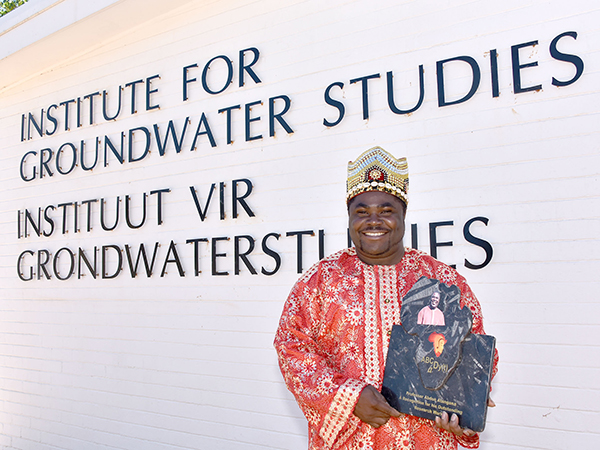Latest News Archive
Please select Category, Year, and then Month to display items
11 June 2021
|
Story Rulanzen Martin
|
Photo Courtesy of artists and the Johannes Stegmann Gallery.
![]()
Liminality is an exhibition of first-, second- and third-year student’s work in the
Department of Fine Arts at the University of the Free State (UFS). The works are from 2019 and 2020. Created during the hard lockdown of 2020, the artworks provide a glimpse of what students had to deal with and overcome during these times.
In a proposal for the exhibition, Angela de Jesus, Curator of the UFS Art Galleries, wrote: “The subtitle of the exhibition is ‘threshold, transition, transformation’ and it refers to the creative processes that students engaged with
in these adverse circumstances resulting in a wide array of artworks in both traditional and adapted mediums.”
The exhibition speaks to our shared experiences of insecurity, fragility, and discord, and to the resourcefulness and immutability of creative expression.
The virtual exhibition runs until 2 July 2021.
The exhibition is also currently available for viewing at the Johannes Stegmann Art Gallery, Sasol Library, UFS Bloemfontein Campus. Monday - Friday 09:00 - 16:00.
 MEGAN JOHNS, Battleground, Tobacco, charcoal dust, plaster of paris and resin, 93.5 x 50 x 7.5 cm
MEGAN JOHNS, Battleground, Tobacco, charcoal dust, plaster of paris and resin, 93.5 x 50 x 7.5 cm
 JACOBETH SELINGA, Linda, Installation: Found bed, wool and thread, 257 x 196 x 91 cm
JACOBETH SELINGA, Linda, Installation: Found bed, wool and thread, 257 x 196 x 91 cm
 POLOKO MOHANOE, Prayer for rain, Gouache on Fabriano, 66 x 72.8 cm
POLOKO MOHANOE, Prayer for rain, Gouache on Fabriano, 66 x 72.8 cm
 SEBOTSE SELAMULELA, In my image (Coronavirus head), Clay, 35 x 40 x 60 cm
SEBOTSE SELAMULELA, In my image (Coronavirus head), Clay, 35 x 40 x 60 cm
 WILLIAM SHAER, Creator, Deconstructed chair, koat wood and Imbura wood, 100 x 75 x 45 cm
WILLIAM SHAER, Creator, Deconstructed chair, koat wood and Imbura wood, 100 x 75 x 45 cm
 Johannes Stegmann Gallery
Johannes Stegmann Gallery
 Interior of the Johannes Stegmann Gallery
Interior of the Johannes Stegmann Gallery
Africa the birthplace of mathematics, says Prof Atangana
2017-11-17

Prof Abdon Atangana from the UFS Institute for Groundwater Studies.
Photo: Supplied
Prof Abdon Atangana from the Institute for Groundwater Studies at the University of the Free State recently received the African Award of Applied Mathematics during the International conference "African’s Days of Applied Mathematics" that was held in Errachidia, Morocco. Prof Atangana delivered the opening speech with the title "Africa was a temple of knowledge before: What happened?” The focus of the conference was to offer a forum for the promotion of mathematics and its applications in African countries.
When Europeans first came to Africa, they considered the architecture to be disorganised and thus primitive. It never occurred to them that Africans might have been using a form of mathematics that they hadn’t even discovered yet.
Africa is home to the world’s earliest known use of measuring and calculation. Thousands of years ago Africans were using numerals, algebra and geometry in daily life. “Our continent is the birthplace of both basic and advanced mathematics,” said Prof Atangana.
Africa attracted a series of immigrants who spread knowledge from this continent to the rest of the world.
Measuring and counting
In one of his examples of African mathematics knowledge Prof Atangana referred to the oldest mathematical instrument as the Lebombo bone, a baboon fibula used as a measuring instrument, which was named after the Lebombo Mountains of Swaziland. The world’s oldest evidence of advanced mathematics was also a baboon fibula that was discovered in present-day Democratic Republic of Congo.
Another example he used is the manuscripts in the libraries of the Sankoré University, one of the world’s oldest tertiary institutions. This university in Timbuktu, Mali, is full of manuscripts mainly written in Ajami in the 1200s AD. “When Europeans and Western Asians began visiting and colonising Mali between the 1300s and 1800s, Malians hid the manuscripts in basements, attics and underground, fearing destruction or theft by foreigners. This was certainly a good idea, given the Europeans' history of destroying texts in Kemet and other areas of the continent. Many of the scripts were mathematical and astronomical in nature. In recent years, as many as 700 000 scripts have been rediscovered and attest to the continuous knowledge of advanced mathematics and science in Africa well before European colonisation.
Fractal geometry
“One of Africa’s major achievements was the advanced knowledge of fractal geometry. This knowledge is found in a wide aspect of Africa life: from art, social design structures, architecture, to games, trade and divination systems.
“The binary numeral system was also widely known through Africa before it was known throughout much of the world. There is a theory that it could have influenced Western geometry, which led to the development of digital computers,” he said.
“Can Africa rise again?” Prof Atangana believes it can.
He concluded with a plea to fellow African researchers to do research that will build towards a new Africa.